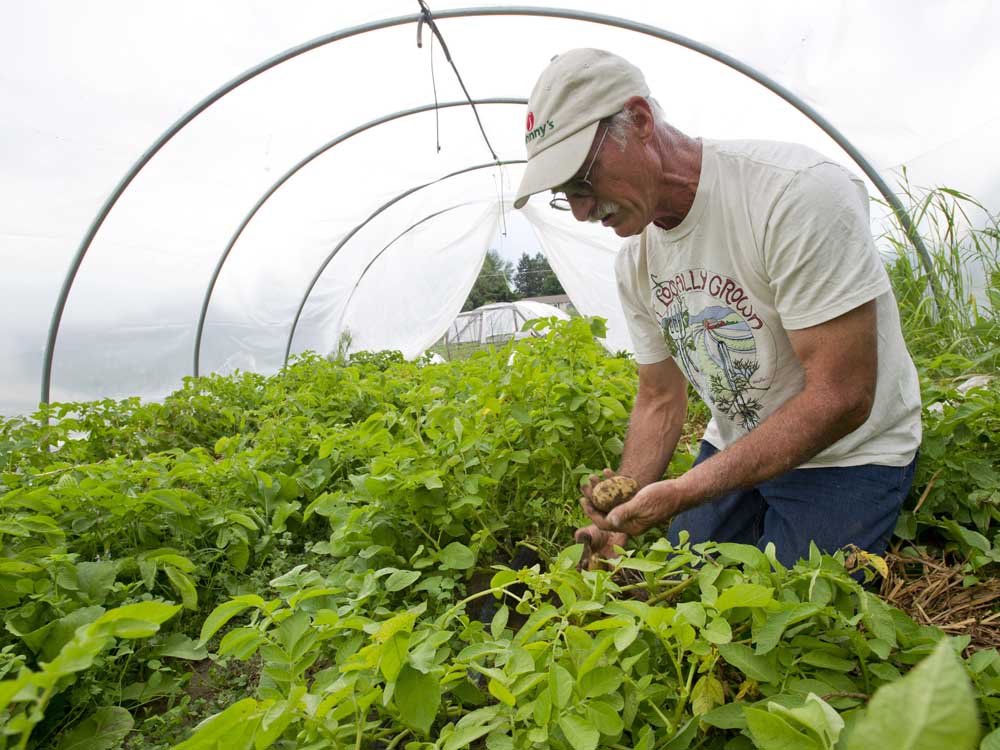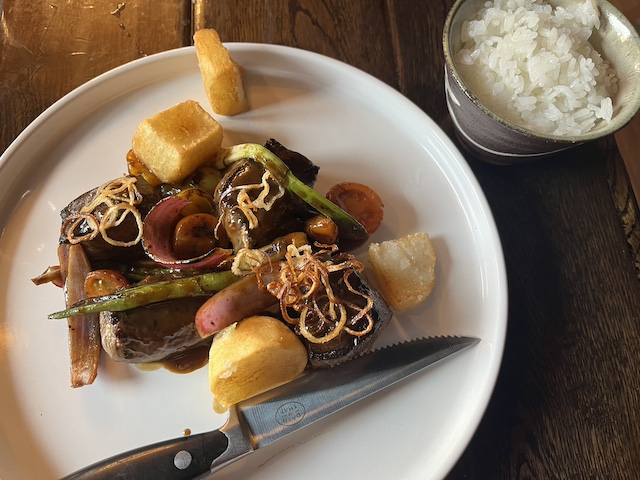Tips for growing perfect potatoes
Published 12:00 am Tuesday, June 14, 2016

- Ryan Brennecke / The BulletinFields Farm’s Jim Fields digs up a handful of potatoes from one of his potato crops earlier this month.
When it comes to growing vegetables, “potato plants are one of the biggest producers of food for the space they take up,” said Jim Fields, owner of Fields Farm on the east side of Bend. In just a few square feet, a single plant can produce 1 to 3 pounds of potatoes. I was happy to find Fields’ potatoes growing in three different stages when I visited him on a recent rainy day, ready to pepper him with potato questions.
Potatoes do best when they’re watered consistently, planted in full sun and fertile soil. With these three basic needs met, local sources say, they thrive nearly every place they’re planted. From simple, hilled field rows and raised beds, to straw bales, barrels and towers made of tires, there is no shortage of simple and ingenious ways to grow potatoes.
Planting and soil
“Let’s start with where the potato plant begins, and that’s with the seed potato,” said Fields, as he led me through his farm stand and around into a warm potting shed with broad windows. Among the other vegetable starts, there was a flat tray each of purple, red and white potatoes beginning to sprout.
“Remember,” he warned, “to only use certified seed potatoes.”
Tempting as it may be to plant past-their-prime potatoes that have begun to sprout, resist, said Fields. Potatoes sold to grocery markets — even the organic ones — have been treated with sprout inhibitors (rosemary oil, he said, in the case of organic) to increase shelf life. Those that do sprout, he said, will rarely grow into productive plants.
Fertile soil is a must, and an additional helping of nutrients halfway through their season is nearly as necessary, Fields said. Begin with one part quality compost mixed into two parts native soil, and supplement with either liquid nutrients (such as Alaska fish fertilizer) or, alternatively, another helping of well-aged compost.
Using hills, mounds, towers or containers, plant seed potatoes just a few inches deep, and keep soil moist. Plant rows 2 feet apart, with seed pieces every 9 to 12 inches. For tire towers, plant in the bottom of just one tire filled with soil, so adequate sunlight will reach the plant. As growth continues, top plants off with soil and mulch to create a loosely packed nest area, adding more soil, mulch (and tires), as the plant matures to fill the tower.
“If I want smaller potatoes, I plant them closer together. If I want great big lunkers, I’ll plant them further apart,” he said. “It depends on the variety, but plants competing for nutrients typically make smaller potatoes and more of them.”
Hills or beds, towers or containers, “They’re making their potatoes under the soil,” Fields said. “So you want to continue adding to the space where they develop by continuing to build their soil base up as they grow.”
Moisture and mulch
“Part of the reason you hill is to have more soil to hold water right where they need it, at the root zone,” Fields said. After all, potatoes are 90 percent water.
“Mulching helps to protect the entire soil profile and keep it moist,” Fields said, bending to explain the hops spread around the base of his plants. “With our shallow, sandy soils, anything we can do to keep the moisture where it’s needed is helpful.”
“Even though the hops are nearly dry and ready to blow away, the soil stays moist,” Fields showed me, exposing the soil underneath a handful of hops. A dry and dusty topsoil wicks moisture up and into the environment. Mulch helps slow this process, keeping the entire soil profile moist.
Straw is another great mulch, adding carbon as it breaks down. Using weed-free hay can add nitrogen. Layering mulch and soil when container gardening helps create a looser nest area underneath the plant, making it easier to remove young potatoes for early eating.
Using mulch can also help stifle weed growth and buffer fluctuating temperatures.
Varieties and sources
Yukon Gold, Red Norland and Viking Purple will all “produce ample crops in Central Oregon,” according to Oregon State University Master Gardener Nancy Glick. These and other common varieties can be found at local garden and nursery retailers. For special varieties, seek out an online retailer such as potatogarden.com, where Fields purchased his this year.
His German Butterballs will have a yellow flesh that’s “like a stick of butter inside,” Fields said. Mountain Rose produces red-skinned, waxy potatoes. The violet-fleshed Purple Majesty has a gorgeous, deep color — one of nature’s indications, Fields said, of the added nutrition inside.
Nutrition
The low-carb craze of the not-so-distant past may have unjustly put potatoes on the no list, citing high starch content and empty calories as reasons.
With more potassium than a banana, more usable iron than any other vegetable and over 40 percent of your daily recommended intake of vitamin C — not to mention the 10 percent of your RDA of B-6 and the long list of trace minerals such as magnesium, folate and phosphorous — no one should call the approximately 110 calories in a medium-sized potato empty.
Harvesting
“You can take a potato from a potato plant any time you want,” Fields said. Small tubers harvested early are referred to as new potatoes and have thinner skins than their mature counterparts. These are best eaten immediately, as its thin skin makes it more susceptible to both damage during harvest and shriveling soon after. Enjoy new potatoes within a week or two boiled, in soups, as cottage-fried potatoes or in salads.
After plants have flowered and reached maturity, they’ll begin to droop. Stop watering at that point, and allow the tops of plants to dry out. If first frosts are expected early, you can hasten this process by incrementally cutting leaves off over the course of a week or so. Rapid vine death by any means can result in the darkening of the flesh. Experts say a slower process allows mature potatoes to cure in the ground, developing tougher skins to protect them during harvest and to better retain moisture during storage.
History
Surprisingly, our area was once one of the highest yield potato-producing areas in the world. Today, Central Oregon has just a handful of large-scale potato farmers left. Older generations may still remember a time when the potato industry was a vital part of our economy, or they may remember the annual Potato Festival in Redmond. The popular festival drew people from all around with growing and cooking competitions, including a pageant crowning “Miss Spud” from area high school seniors. Who knew we even have our own potato variety, the Des-Chutes russet?
Pride and history aside, today’s prices keep potatoes from being quite the cash crop they once were here. Nonetheless, smaller area farms and backyard gardeners alike continue to grow them year after year with great success.
— Reporter: laurakessinger@gmail.com






